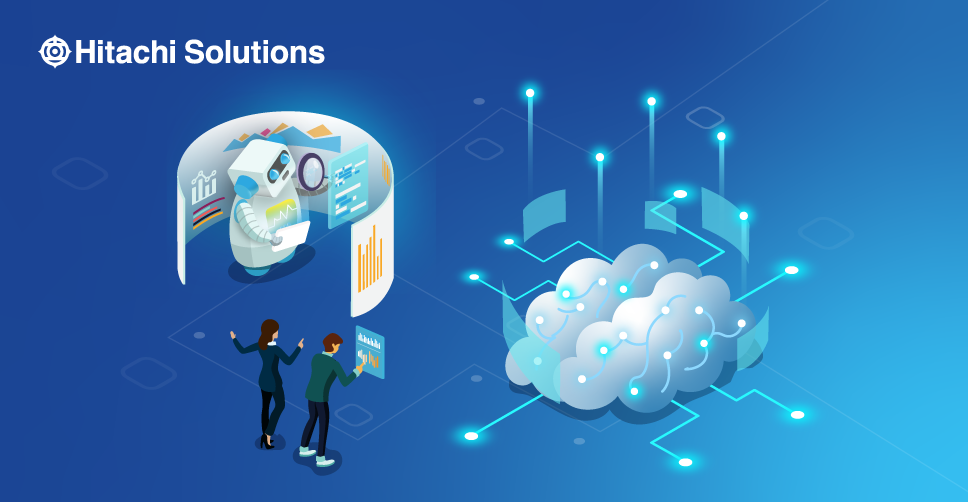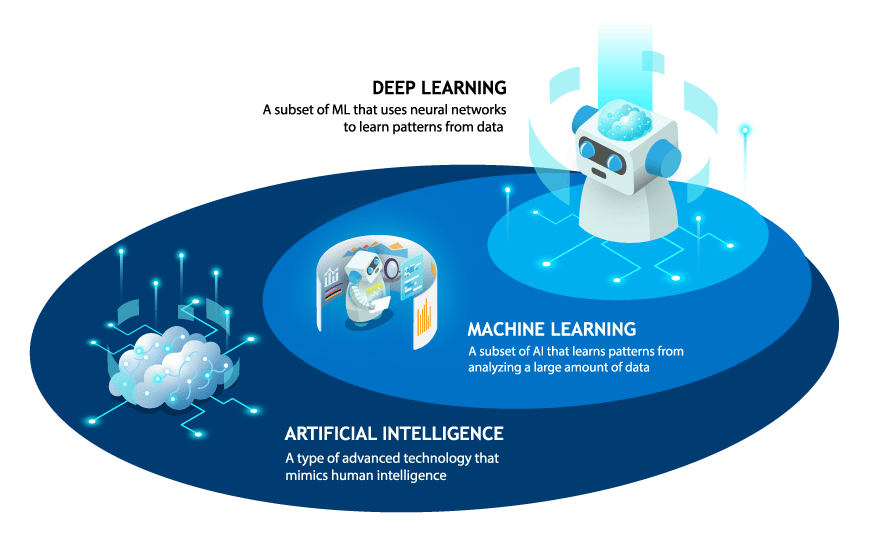

AI, Machine Learning, and Predictive Analytics – How Technology is Changing the Insurance Landscape
Insurance companies today know the value of digital technologies – these tools have transformed the industry across all facets of operations
Read the BlogFrom self-driving cars to a computer that plays chess, technology has come a long way since its debut. Artificial intelligence (AI), machine learning (ML), and deep learning (DL) are integrated into today’s society, in every industry, at every level. From predicting equipment outages to interacting with customers by chatbot, these technologies are vital for modern business operations.
AI, ML, and DL are an iconic subset of computer science that is changing every industry, from healthcare to sports management. Read on to learn more about these high-tech advancements and how they are used in business every day.
History of Artificial Intelligence & Machine Learning
The concept of artificial intelligence (AI) has existed for centuries and can trace its origins all the way back to classical antiquity. AI as we know it today, however, has more recent roots. In 1950, mathematician Alan Turing published “Computing Machinery and Intelligence,” which aimed to answer the question, “Can machines think?” This paper would become a method to test intelligence in a machine, now known as the Turing test.
Since the time of Turing, numerous advances have been made in the field of AI, including the development of a computer program that could play checkers against a human. Created by computer scientist Arthur Samuel, this program was able to record or remember all previous moves and apply this to reinforcement learning. This meant that the computer would learn from past mistakes and play at a more intelligent level each time. Samuel continually improved upon this program and in 1952 coined the term “machine learning.”
In the late 1960s through the 1990s, AI gained international recognition thanks to popular movies like “2001: A Space Odyssey” (1968), “Star Wars” (1977), and “Electric Dreams” (1984). During this time, advancements were made in AI that rivaled those shown on the silver screen. By the 2000s, AI had become mainstream, appearing everywhere from smart assistants to online mapping services. Though not as well known by the general populace, machine learning has also continued to evolve over the decades and is now one of the most common applications of AI today.
What is Artificial Intelligence?
While there is no one universally recognized definition of artificial intelligence, it can be summed up as, “a wide-ranging branch of computer science concerned with building smart machines capable of performing tasks that typically require human intelligence.”
There are two types of AI: narrow AI and general AI.
Narrow AI, which is also known as weak AI, is a term used to describe AI systems that focus on a particular task that would ordinarily require human intelligence. It gets its name from its inherent limitations — narrow AI can only be used to complete a limited task, or one task at a time. Narrow AI is the most common form of artificial intelligence can be found everywhere from smart assistants and facial recognition systems to search engine recommendations and predictive maintenance models.
By comparison, general AI, or strong AI, is meant to replicate human intelligence and complete the same intellectual tasks that a human being could — think C3PO from the “Star Wars” series. According to TechTalks, this involves being able to mimic “common sense, background knowledge, transfer learning, abstraction, and causality.” General AI is still largely theoretical in nature. That said, certain AI applications, such as emotional analysis — which relies on natural language processing to register the underlying emotion in text — represent the early development stages of this technology.
What is Machine Learning?
Machine learning is a branch of artificial intelligence that enables computers to “learn” — that is, to use large quantities of structured, labeled data and algorithms to identify patterns and make predictions, all without being explicitly programmed to do so. Perhaps the most obvious example of machine learning is Google Maps, which analyzes past and present traffic data patterns to recommend the fastest route.
Where machine learning really gets exciting is deep learning. Deep learning is a subset of machine learning that uses artificial neural networks — computing systems modeled after the human brain — to ingest and learn from both structured and unstructured data. An example of deep learning in action is driverless cars, which inherently understand the rules of the road and can react in real-time to things like a stop sign or a person crossing the street.
*Graphic illustrating the relationship between AI, ML, and deep learning*
Artificial Intelligence – A type of advanced technology that mimics human intelligence.
Machine Learning – A subset of AI that learns patterns from analyzing a large amount of data.
Deep Learning – A subset of ML that uses neural networks to learn patterns from data.

AI vs. Machine Learning vs. Deep Learning: Key Differences
Although AI, machine learning, and deep learning all belong to the same family, they each have unique qualities and applications. Refer to the chart below to understand key differences between the three. This information in this chart was compiled by TechGig, Forbes, and Javapoint.
| Artificial Intelligence | Machine Learning | Deep Learning | |
|---|---|---|---|
| How It Works | Simulates human intelligence | Learns from past data patterns without being specifically programmed to do so | Mimics biological neural networks in the human brain |
| Engineering | Created from programming | Relies on large quantities of structured data and algorithms to learn | Relies on large quantities of structured and unstructured data and algorithms to learn |
| Common Examples | Smart assistants, chatbots | Google search, spam filters, demand forecasting, product recommendations | Autonomous vehicles, facial recognition, translation software, tweet sentiment |
| Desired Outcome | Mimic human intelligence to solve complex problems | Analyze and learn from data to perform a particular task | Complete tasks that traditionally require human intelligence |
Real-world Applications of Artificial Intelligence & Machine Learning
AI and machine learning applications can be found in every industry. These technologies optimize business processes, enhance productivity, and are often used to perform predictive analysis. Here are just a few examples from various industries:
- Insurance: These advanced technologies empower insurers to identify, assess, and underwrite emerging risks and identify new revenue sources semi-automatically.
- Finance: Financial services firms can leverage AI to quickly and effectively perform investment analysis, assess competitive landscape, and ensure compliance.
- Manufacturers: Manufacturers can improve supply chain productivity by using AI to remotely monitor, analyze, and assess equipment performance around the clock.
- Retailers: Retailers use demand forecasting to predict industry shifts and make proactive changes to a company’s marketing, business, and merchandising strategies.
- Entertainment: Most streaming platforms utilize AI-powered algorithms to recommend content based on users’ viewing history.
- Healthcare: Hospitals and other healthcare organizations can implement natural language processing, a branch of AI to swiftly digitize and organize documentation, examine data, and make better informed decisions.
- Tech: One way the tech industry can use AI is to flag cybersecurity threats, fraud attempts and other cyber risks.
Unlock the Potential of Artificial Intelligence & Machine Learning with Hitachi Solutions
Hitachi Solutions enables enterprise-level organizations to embrace cutting-edge technologies, including artificial intelligence and machine learning, in order to help them see beyond the competition and achieve scalable business growth.
One of our popular products, Azure Databricks, empowers data scientists, data engineers, and data analysts with a full suite of capabilities to explore, model, manage, and visualize data. From data ingestion and featurization, to model building and training, all the way to serving and monitoring, the Databricks Lakehouse Platform unifies all of the core components of a data science environment. Data teams can build robust, reproducible machine learning models at scale and present results in custom dashboards to provide immediate insights to end-users.
Learn how your company can utilize AI, ML, and DL with our Insights Digital Compass business strategy. Upgrade to modern platforms that elevate your business and promote business growth.


